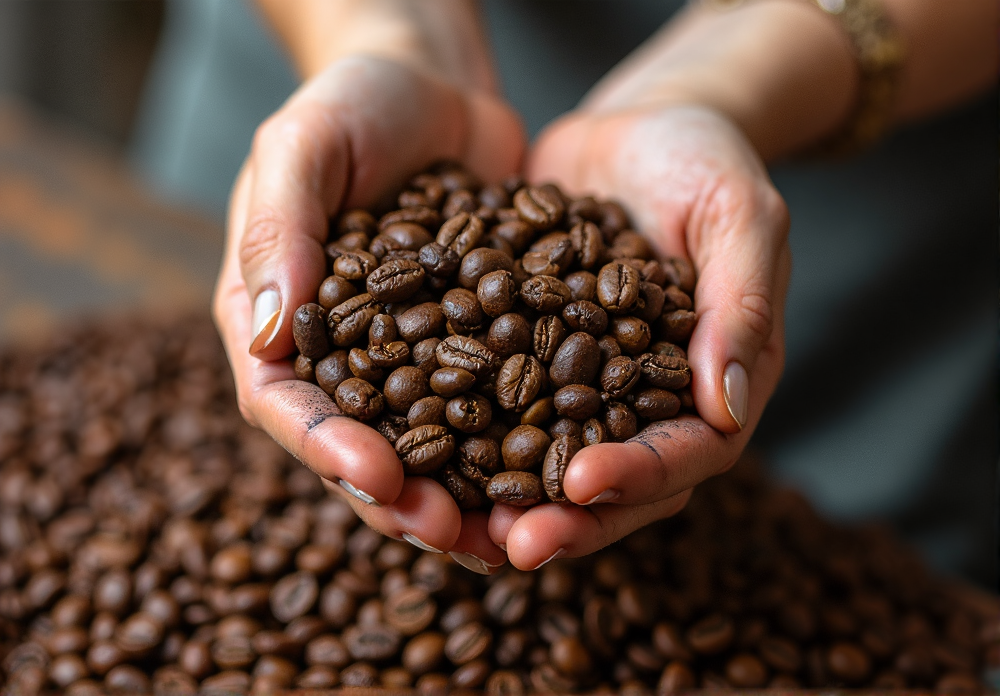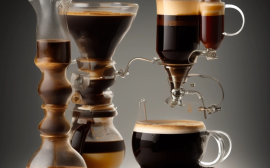The Symphony of Single-Origin: An Introduction to Roast Profiling
In the realm of specialty coffee, single-origin beans reign supreme, showcasing the intricate dance between terroir, processing methods, and the roaster’s artistry. These beans, each a product of its unique environment, harbor a distinct flavor profile waiting to be unveiled. The roaster’s role transcends the mere application of heat; they act as a conductor, orchestrating a transformative symphony of flavor. This isn’t simply about browning beans; it’s about understanding the nuanced relationship between time, temperature, and the bean’s inherent potential.
This article delves into the art and science of roast profiling, providing a comprehensive guide for both home and professional roasters seeking to maximize the potential of these exceptional coffees. From understanding the impact of origin characteristics on roast development to mastering the control of temperature progression and airflow, we’ll explore the key elements that contribute to a truly exceptional cup. Imagine a Yirgacheffe from Ethiopia, with its delicate floral aromatics and citrusy acidity. Its roasting journey demands a different approach compared to a Sumatran Mandheling, known for its earthy undertones and full body.
The roaster must consider the bean’s density, moisture content, and processing method, tailoring the roast profile to highlight its inherent qualities. This involves meticulous control over temperature and airflow, navigating the delicate balance between preserving origin characteristics and developing desirable roast flavors. The science of coffee roasting comes into play here, as the Maillard reaction and caramelization processes transform the bean’s chemical composition, unlocking a complex tapestry of flavors. For instance, a slower roast can accentuate sweetness and body, while a faster roast might highlight brightness and acidity.
By understanding these chemical transformations, roasters can manipulate the roast profile to achieve specific flavor outcomes. Furthermore, sensory evaluation, or cupping, plays a crucial role in assessing the final product. Through careful observation of aroma, flavor, body, acidity, and aftertaste, roasters can refine their techniques, ensuring consistency and quality. Whether you’re a home roaster experimenting with a small batch roaster or a professional operating a large-scale drum roaster, the principles of roast profiling remain the same. This journey of discovery involves continuous learning, experimentation, and a deep appreciation for the intricate world of single-origin coffee.
Understanding the Bean: Origin, Processing, and Flavor Potential
Before diving into the technicalities of roast profiling, it’s crucial to understand that single-origin coffees are not monolithic. Each coffee origin, from the high-altitude farms of Ethiopia to the volcanic slopes of Sumatra, presents a unique set of characteristics that the roaster must consider. A Yirgacheffe from Ethiopia, known for its delicate floral notes and bright acidity, will demand a different approach than a Sumatran Mandheling, prized for its earthy complexity and full body. This inherent variability necessitates a deep understanding of the bean’s origin, processing method, and inherent flavor potential before embarking on the roasting journey.
A successful roast profile isn’t a one-size-fits-all solution, but rather a tailored approach that unlocks the distinct characteristics of each bean. The bean’s density, moisture content, and processing method (washed, natural, honey) all contribute to its unique roasting requirements. For instance, a dense, low-moisture bean like a Sumatran will require a longer drying phase and a higher charge temperature to ensure even roasting. Conversely, a high-moisture bean from a washed process, like a Kenyan, might be more susceptible to scorching and require a gentler approach.
Understanding these nuances is the first step towards crafting a roast profile that maximizes the bean’s potential. Scott Rao, a renowned coffee roasting expert, emphasizes the importance of bean analysis, stating that “knowing the physical characteristics of your beans is as important as knowing your roasting machine.” Furthermore, the processing method plays a significant role in shaping the bean’s flavor profile and subsequent roasting needs. Washed coffees, known for their clean cup and pronounced acidity, often require a roast profile that highlights these characteristics.
Natural processed coffees, on the other hand, tend to exhibit more fruit-forward and complex flavors, demanding a roast that balances sweetness and body without obscuring these nuances. Honey processed coffees fall somewhere in between, offering a bridge between the clarity of washed and the intensity of naturals. Recognizing these processing-induced flavor profiles is crucial for developing a targeted roast profile. For example, a naturally processed Ethiopian Sidamo might benefit from a slightly slower roast development to enhance its inherent fruit notes, while a washed Kenyan SL-28 might thrive with a faster development to accentuate its bright acidity.
By considering these factors, roasters can tailor their approach to each coffee, unlocking its unique flavor potential and achieving optimal results. This attention to detail, combined with meticulous data logging and sensory evaluation, allows roasters to refine their craft and consistently produce exceptional coffee. Finally, consider the desired flavor outcome. Are you aiming for a bright, acidic cup, or a full-bodied, chocolatey brew? This desired outcome will inform decisions throughout the roast process, from the initial charge temperature to the development time ratio.
For example, if you’re roasting a Colombian Supremo with the goal of highlighting its caramel sweetness, you might opt for a longer development time to enhance those flavors. Alternatively, if you’re roasting a Rwandan Bourbon and aiming for a bright, citrusy profile, a shorter development time might be preferred. Ultimately, understanding the interplay between bean characteristics, processing methods, and desired flavor outcomes is essential for mastering the art of single-origin coffee roasting and achieving consistent, high-quality results. This deep understanding of the raw material, combined with a scientific approach to roasting, empowers roasters to transform green beans into exquisite cups of coffee that showcase the unique terroir of each origin.
Roast Curve Fundamentals: Drying, Browning, and Development
The roast curve, visually represented as a graph of temperature over time, serves as the roaster’s navigational tool, guiding the transformation of green beans into aromatic, flavorful coffee. This roadmap is typically segmented into three distinct phases: drying, browning (Maillard reaction), and development, each playing a crucial role in shaping the final cup. The drying phase, the initial stage of the roast, focuses on evaporating moisture from the green beans. This stage is critical for ensuring even roasting throughout the bean’s structure.
A slow and controlled approach during drying prevents scorching the bean’s surface while allowing heat to penetrate to the core. Think of it like preheating an oven before baking a cake – ensuring a consistent temperature throughout is key for even cooking. In coffee roasting, this translates to a smooth and consistent progression into the next phase. The browning phase, marked by the Maillard reaction, is where the magic truly begins. As the bean’s internal temperature rises, a complex chemical reaction occurs between amino acids and reducing sugars, creating hundreds of flavor compounds.
This is where the characteristic aromas of coffee begin to develop, from nutty and chocolatey to caramel and toasty. The rate of temperature increase, known as the Rate of Rise (RoR), plays a critical role during this phase. A faster RoR can lead to more intense sweetness, while a slower RoR might accentuate more nuanced flavors. Professional roasters meticulously control the RoR to achieve specific flavor profiles based on the bean’s origin and desired outcome.
The development phase, commencing after the first audible crack, is where the bean’s final flavor profile is refined. First crack signifies the release of trapped gases within the bean and marks the transition into the development phase. This stage is crucial for balancing sweetness, acidity, and body. Extending development time can lead to a fuller body and decreased acidity, while a shorter development time might highlight brighter acidity and a lighter body. The Development Time Ratio (DTR), calculated as the percentage of total roast time spent after first crack, is a key metric used by roasters to track and replicate desired roast profiles.
For instance, a longer DTR might be favored for a Sumatran Mandheling to emphasize its earthy notes, while a shorter DTR could highlight the floral aromatics of an Ethiopian Yirgacheffe. Careful manipulation of time and temperature during this phase is essential for achieving the desired balance and complexity in the final cup. Analyzing the roast curve allows roasters to understand the impact of their adjustments on flavor development, contributing to the art and science of crafting exceptional coffee.
Temperature Progression: The Art of Controlled Heating
Temperature progression is indeed the linchpin of any meticulously crafted roast profile, particularly when dealing with the nuances of single-origin coffee. A consistent and controlled temperature ramp, often visualized through a roast curve, is not merely about applying heat; it’s about orchestrating a complex series of chemical reactions that ultimately define the final cup. The rate of rise (RoR), a key metric in coffee roasting, represents the change in bean temperature over time and is a critical parameter to monitor.
A rapid RoR early in the roast, often referred to as ‘flicking’ or ‘crashing’, can lead to uneven development within the bean, causing the exterior to roast faster than the interior, and resulting in undesirable flavors such as astringency or a hollow taste. Conversely, a slow RoR, especially in the initial stages, can result in a baked, flat taste, lacking the vibrancy and complexity that single-origin beans are prized for. The goal, therefore, is to find a delicate balance that allows the bean to develop its full flavor potential without scorching or stalling, a challenge that demands both precision and experience.
Different single-origin coffees, due to their inherent density, moisture content, and processing methods, will respond uniquely to temperature ramps, necessitating careful adjustments and iterative experimentation. The initial phase of the roast, often termed the ‘drying phase,’ is crucial for preparing the bean for the subsequent stages. During this phase, the goal is to gently and evenly remove moisture from the bean without imparting any significant heat energy. This process ensures that the bean’s internal structure is primed for the more intense reactions to come.
A slow, steady temperature ramp during this phase, typically aiming for a moderate RoR, is generally preferred. For example, a dense Ethiopian Yirgacheffe might require a slightly longer drying phase with a lower RoR than a less dense Sumatran Mandheling. This careful approach prevents the beans from developing defects, such as ‘tipping’ or ‘scorching,’ that could compromise the final flavor profile. Precise control over airflow is also critical at this stage to effectively manage moisture removal and prevent stalling.
As the roast progresses into the ‘browning phase,’ marked by the onset of the Maillard reaction, the temperature ramp becomes more critical. The Maillard reaction is responsible for the development of hundreds of flavor compounds and is highly sensitive to temperature and time. A well-managed RoR during this phase ensures a consistent and even development of these complex flavors. Too rapid of a temperature increase can cause the Maillard reaction to proceed too quickly, resulting in a loss of nuance and potentially producing undesirable flavors.
Conversely, a sluggish temperature progression during this phase can lead to a muted or underdeveloped flavor profile. Professional roasters often employ a ‘declining RoR’ during this phase, gradually reducing the rate of temperature increase to allow for a more controlled and even development of flavor compounds. This is where the art of coffee roasting truly shines, as subtle adjustments to the temperature ramp can make a significant difference in the final cup. The approach to temperature progression also requires a nuanced understanding of the specific characteristics of the single-origin bean being roasted.
For instance, a naturally processed Ethiopian coffee, known for its intense fruit-forward notes, might benefit from a slightly more aggressive temperature ramp during the browning phase to enhance its inherent sweetness and acidity. Conversely, a washed processed Colombian coffee, prized for its balance and clarity, might require a more gentle temperature progression to prevent over-development and maintain its delicate flavor profile. Furthermore, the density of the bean plays a significant role; denser beans typically require a more extended period of heat application to achieve proper internal development, whereas less dense beans may require a more moderate approach to prevent scorching.
Monitoring the rate of rise (RoR) throughout the roast is essential for maintaining consistency and achieving the desired flavor profile. Modern coffee roasting software allows roasters to precisely track the RoR in real-time, enabling them to make informed adjustments as the roast progresses. Roasters use this data, along with sensory evaluation through cupping, to fine-tune their roast profiles. Consistent logging of temperature data, combined with detailed notes on the sensory attributes of the final brew, allows for continuous improvement and refinement of roast profiles. This iterative process is key to unlocking the full potential of each single-origin bean and ensuring that the unique characteristics of the origin are accurately reflected in the final cup, whether for home roasting enthusiasts or professional coffee roasters.
First Crack and Development Time Ratio: Balancing Sweetness, Acidity, and Body
First crack, that distinctive popping sound reminiscent of popcorn, signifies a pivotal moment in the coffee roasting process. It marks the beginning of the development phase, the critical window where the bean’s inherent flavors truly begin to blossom. As the internal bean temperature surpasses approximately 200°C (392°F), trapped gases, primarily carbon dioxide and water vapor, force their way out, resulting in the audible first crack. This stage signals the transition from the endothermic drying and browning phases to the exothermic development phase, where the bean’s sugars caramelize and its acids transform, shaping the final cup profile.
The development time ratio (DTR), calculated as the time elapsed after first crack divided by the total roast time, becomes a crucial control lever in the roaster’s arsenal. The DTR significantly influences the balance of sweetness, acidity, and body in the final brew. A longer DTR, typically ranging from 15-25% of total roast time, generally yields a sweeter, more rounded cup with a fuller body. The extended development allows for more thorough caramelization of sugars, contributing to deeper, richer flavors and a heavier mouthfeel.
For example, a Sumatran Mandheling might benefit from a longer DTR to enhance its characteristic earthy and syrupy notes. Conversely, a shorter DTR, perhaps 10-15%, tends to produce a brighter, more acidic coffee, highlighting the fruit-forward characteristics often found in Ethiopian Yirgacheffes or Kenyan coffees. The shorter development period preserves the volatile aromatic compounds responsible for these vibrant flavors, while also maintaining a lighter body. However, manipulating DTR isn’t simply about extending or shortening the time after first crack.
Temperature progression throughout the entire roast plays a vital role. A rapid temperature climb during development can lead to underdeveloped flavors, even with a longer DTR. Conversely, a slower, more controlled temperature rise can allow for more nuanced flavor development, even within a shorter DTR window. This is where the art of roast profiling comes into play, requiring the roaster to carefully balance time and temperature to unlock a bean’s full potential. Determining the optimal DTR for a specific single-origin coffee requires careful experimentation and meticulous sensory evaluation.
Cupping, the standardized process of evaluating coffee’s aroma, flavor, and body, is essential for assessing the impact of different DTRs. Roasters often conduct comparative cuppings, roasting the same beans with varying DTRs, to identify the sweet spot that best showcases the coffee’s unique characteristics. This iterative process, combining data analysis from roast logs with sensory feedback, allows roasters to refine their profiles and consistently produce exceptional coffee. Moreover, understanding the interplay between DTR and the roast curve, especially the rate of rise (RoR) during development, allows for fine-tuning the balance between sweetness, acidity, and body, ultimately shaping the final cup profile to highlight the distinct terroir of each single-origin coffee.
Furthermore, the density and moisture content of the green coffee beans influence the roast’s progression and the ideal DTR. Denser beans require more energy to reach first crack and generally benefit from a slightly longer development time to fully develop their inherent flavors. Conversely, beans with higher moisture content may require careful management of the initial stages of the roast to avoid scorching, potentially impacting the later development phase and the ideal DTR. Consequently, adjusting the roasting approach based on these bean characteristics is crucial for achieving the desired flavor profile.
Logging, Data Analysis, and Sensory Evaluation: Refining the Roast
The meticulous logging of roast data is the cornerstone of any systematic approach to coffee roasting, especially when working with the nuanced profiles of single-origin coffee. Detailed records should capture not only temperature readings at regular intervals—ideally every 15 to 30 seconds—but also precise timestamps for critical events such as the start of the roast, first crack, and the conclusion of the roast. Airflow adjustments, drum speed settings, and even ambient temperature fluctuations within the roasting environment can all impact the final cup and should be meticulously documented.
This granular data allows roasters, whether in home roasting or professional roasting settings, to reconstruct the roast curve, identify potential inconsistencies, and fine-tune their approach for each unique bean. The application of data analytics to these records enables a scientific approach to flavor development, moving beyond guesswork to informed adjustments. These data points, when visualized as a roast curve, become a powerful diagnostic tool. A roast curve that deviates from the desired trajectory—perhaps a rapid temperature spike early in the roast or a stalled development phase after first crack—can directly correlate with specific flavor defects or a lack of desired characteristics.
For example, an excessively rapid rate of rise (RoR) during the browning phase can lead to underdeveloped flavors, often described as grassy or vegetal, while a prolonged development time ratio (DTR) might result in a roast that is overly bitter or ashy. By analyzing these curves, roasters can identify precisely where adjustments are needed, whether it’s modifying the initial charge temperature, adjusting airflow to control heat transfer, or altering the overall roast time. This iterative process of data collection and analysis is fundamental to achieving consistent and high-quality results.
However, data alone is insufficient. Sensory evaluation, primarily through standardized cupping protocols, is an equally vital component of refining roast profiles. Cupping provides an objective framework for assessing the flavor characteristics of each roast, allowing roasters to connect the data-driven aspects of roasting with the subjective experience of taste. A standardized cupping procedure ensures that variables are controlled, allowing for a more accurate assessment of coffee flavors. During a cupping session, roasters methodically evaluate each coffee for attributes such as aroma, acidity, body, flavor, and aftertaste, and then assign scores based on a predefined scale.
This process not only helps in identifying desirable attributes but also in pinpointing undesirable ones, such as off-flavors or imbalances that may arise from improper roasting. Flavor descriptors, used during the cupping process, are not merely subjective impressions but rather a lexicon that allows roasters to communicate specific nuances of coffee flavors. Terms such as floral, fruity, chocolatey, nutty, or caramel are not arbitrary; they reflect the presence of specific chemical compounds that are developed during the coffee roasting process.
For example, a coffee with prominent floral notes, such as jasmine or bergamot, might be the result of a carefully controlled roast that preserves the delicate volatile compounds present in the bean. Conversely, a coffee exhibiting chocolatey or nutty notes might have undergone a slightly longer development time, allowing for the Maillard reaction to proceed further. The ability to accurately identify and articulate these flavor attributes is a critical skill for any roaster. By integrating data analysis with sensory feedback, roasters can develop a comprehensive understanding of the relationship between roast parameters and the final cup quality.
The development of a roast profile, therefore, becomes a dynamic process of continuous improvement, where data informs adjustments, and sensory evaluation confirms the impact of those adjustments. This iterative cycle is essential for unlocking the full flavor potential of single-origin coffee, and for consistently producing roasts that meet the expectations of discerning specialty coffee consumers. This approach applies equally to home roasting enthusiasts striving for better results and to professional roasters aiming for the highest quality standards. The combination of meticulous logging, data analysis, and rigorous sensory evaluation forms the bedrock of mastery in coffee roasting.
Quality Control, Case Studies, and Troubleshooting: The Path to Mastery
Achieving consistency in coffee roasting is paramount, especially when showcasing the nuanced flavors of single-origin beans. It’s the cornerstone of a reliable product and a testament to the roaster’s skill. Quality control measures form the bedrock of this consistency. Regular calibration of roasting equipment, ensuring accurate temperature readings and airflow control, is non-negotiable. Meticulous logging practices, documenting every stage of the roast from green bean characteristics to final roast color, provide invaluable data for analysis and replication.
Adherence to established cupping protocols, using standardized procedures for tasting and evaluating coffee, allows for objective assessment and refinement of roast profiles. These protocols, often employing a standardized cupping form like the SCA form, help isolate specific flavor attributes and identify any off-notes or inconsistencies. Beyond these foundational practices, advanced roasters leverage data analysis to fine-tune their approach. Analyzing roast curves, comparing temperature progression and rate of rise (RoR) across different batches, allows for identification of trends and optimization of roast parameters.
For instance, a roaster might discover that a slightly lower RoR during the Maillard reaction enhances the sweetness of a particular Kenyan coffee. This data-driven approach empowers roasters to make informed decisions and achieve repeatable results. Furthermore, integrating sensory evaluation with roast data creates a powerful feedback loop. Cupping roasted samples and correlating tasting notes with specific points on the roast curve allows roasters to pinpoint how adjustments to temperature, airflow, and time impact the final cup.
This iterative process of roasting, cupping, and analyzing is crucial for continuous improvement. Troubleshooting is an inevitable part of the roasting process. Recognizing and addressing common issues like uneven roasting, scorching, or stalling requires both experience and a deep understanding of the underlying science. Uneven roasting, often caused by inconsistent airflow or drum speed, can result in underdeveloped beans alongside over-roasted ones, creating a muddled flavor profile. Scorching, a result of excessively high temperatures, leads to burnt, acrid flavors.
Stalling, where the temperature plateaus or drops unexpectedly, can produce baked flavors and diminish desirable acidity. By carefully observing bean color, monitoring temperature and airflow, and listening for the subtle cues of first and second crack, roasters can identify and mitigate these challenges. Consider a specific example: a light roast for an Ethiopian Yirgacheffe. Targeting a Development Time Ratio (DTR) of 10-12%, the roaster aims to highlight the bean’s delicate floral and citrus notes. A slightly faster RoR during the drying phase might be employed to preserve acidity, while a gentler approach during the Maillard reaction enhances sweetness.
In contrast, a medium roast for a Colombian Supremo, with a DTR of 15-20%, might benefit from a more extended Maillard reaction to develop chocolate and caramel notes. Finally, a darker roast for a Sumatran Mandheling, with a DTR of 20-25%, might emphasize its earthy and bold character through a longer development time and higher final roast temperature. The key is to understand the inherent characteristics of each single-origin bean and tailor the roast profile to unlock its full potential.
Mastering the art of roast profiling is a continuous journey of learning, experimentation, and refinement, demanding both scientific rigor and an artistic sensibility. Whether a home roaster experimenting with a small batch roaster or a professional operating a large-scale commercial machine, the principles remain the same. By embracing the technical aspects of roasting, developing a keen sensory palate, and continually seeking knowledge, roasters can elevate the single-origin coffee experience from bean to cup, delivering exceptional and consistent quality to discerning coffee lovers.



